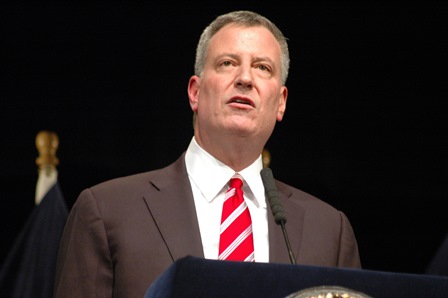It’s a problem solver that doesn’t solve the problem.
That was the reaction many Queens elected officials and activists had to Mayor Bill de Blasio’s “Turning the Tide on Homelessness in New York City” plan that the mayor revealed on Tuesday, Feb. 28. The initiative — which includes building 90 new shelters while moving homeless people out of temporary housing in hotels — aims at stemming the growing rates of homelessness in New York City.
Critics of the plan, however, charged that it does not address the true cause of homelessness: skyrocketing rents and people being forced out of their homes.
State Senator Tony Avella of Bayside — who is challenging de Blasio in the 2017 mayoral primary — points the finger at the de Blasio administration as to why the homeless crisis in the city has reached the astronomical levels it has, with 60,000 New Yorkers sleeping in the streets on a nightly basis.
“Rather than seeking proactive solutions and strategies to stop the factors that cause homelessness, this mayor is reacting in a delayed fashion only to stop the number of homeless New Yorkers from rising any higher,” Avella said. “This mayor does not wish to reflect on himself and his policies; he refuses to acknowledge that his management is a major reason for the severity of this crisis.
Another potential challenger to de Blasio, Councilman Eric Ulrich of Ozone Park, believes de Blasio’s plan doesn’t go nearly far enough to help the homeless population.
“Mayor de Blasio set expectations so incredibly low [on Tuesday] that you have to wonder if he was even being serious. Over the next four years, he aims to move a mere 2,500 people out of the shelter system. This is an insult to the 60,000 plus New Yorkers who are desperately waiting for permanent housing,” Ulrich said. “Homelessness is at an all-time high. It is a serious issue and deserves serious, thoughtful solutions.”
In Maspeth, the community banded together to protest the de Blasio administration’s push to convert the Holiday Inn Express on 55th Road into a homeless shelter for single adult men. In the mayor’s new plan, he aims to keep the homeless in shelters near their original neighborhoods.
“There’s no doubt that our traveling protests influenced the mayor’s decision,” said Robert Holden, president of Juniper Park Civic Association (JPCA), and a member of the Maspeth-Middle Village Task Force. “It is inhumane to warehouse people in hotels and we are glad we helped the administration see the light on this. Everyone agrees that the homeless from their communities should be helped locally, and this announcement is definitely a step in the right direction.”
Assemblyman Brian Barnwell, who participated in the nightly protests outside of the Maspeth hotel before he was elected, is taking a wait-and-see approach to the new homeless plan.
“The fact of the matter is I don’t believe any politician when they speak. We need to see it in action. You can give a speech, promise things, but if you don’t deliver on things then the whole speech was for nothing,” Barnwell said. “I’m always going to be against any plan that will put the community in danger, especially children, if — and I’m not saying it is going to happen — a shelter is proposed near a school. Even if you engage the community, it has still got to make sense. If you put the neighborhood in danger, I won’t be for it. I do think [de Blasio] is trying to address the situation that is going on, that he has learned from past mistakes. But it comes down to implementation.”
One elected official from the Rockaways, Assemblywoman Stacey Pheffer Amato, has introduced legislation to make sure that the Mayor’s Office has an open line of communication with communities where shelters are planned to be placed.
“My community has struggled with unpredictable placement of the homeless by this administration, hurting both the delivery of vital services and faith in the overall system,” Pheffer Amato said. “In response, I introduced a bill requiring notification of community boards and elected officials. I’m glad the mayor is following our lead on that. I hope that this brings some badly needed, long-overdue planning to the urgent question of homelessness in New York City.”
According to de Blasio’s new plan, there will be a community advisory board established in neighborhoods where shelters are located or are planned to be. These advisory boards will be made of community leaders who will meet regularly with Department of Homeless Services (DHS) staff.
State Senator Joseph Addabbo wants to hear more information on how this plan will get funded and is interested in how the community will be involved in where the shelter sites will be located.
“We have heard and read in the past directly from the mayor’s administration on how it was to curtail the use of hotels as shelter for homeless individuals, only to witness an increase throughout Queens,” Addabbo said. “In spite of all the limited facts and figures, I believe the mayor was short on explaining how he plans to fund this program, or who will provide the essential services for homeless individuals, or how the community will be included in the site selection for the 90 new shelter sites.”

































